

Compact Muon Solenoid
LHC, CERN
| CMS-PAS-B2G-16-011 | ||
| Search for vector-like quark pair production in final states with leptons and boosted Higgs bosons at $\sqrt{s}= $ 13 TeV | ||
| CMS Collaboration | ||
| September 2016 | ||
| Abstract: We present a search for pair-produced vector-like top partners (``T quark'') using data from pp collisions at a center-of-mass energy of $\sqrt{s}= $ 13 TeV that were recorded with the CMS detector in the 2015 data-taking period. The search is carried out in the lepton+jets channel and is most sensitive for final states in which at least one T quark decays to a top quark and a Higgs boson. Since the final decay products tend to be collimated in the detector, jet-substructure techniques are used to identify boosted Higgs boson decays to $\mathrm{ b\overline{b} }$. No deviation from the Standard Model (SM) background prediction is observed in the data and upper 95% confidence level (CL) exclusion limits on the $\mathrm{T\bar{T}}$ production cross section are calculated for multiple branching fraction scenarios of the T quark. Assuming a branching fraction of 100% for the $\mathrm{T}\rightarrow \mathrm{tH}$ decay, T quark masses below 860 GeV (870 GeV expected) can be excluded. | ||
| Links: CDS record (PDF) ; inSPIRE record ; CADI line (restricted) ; | ||
| Figures | |
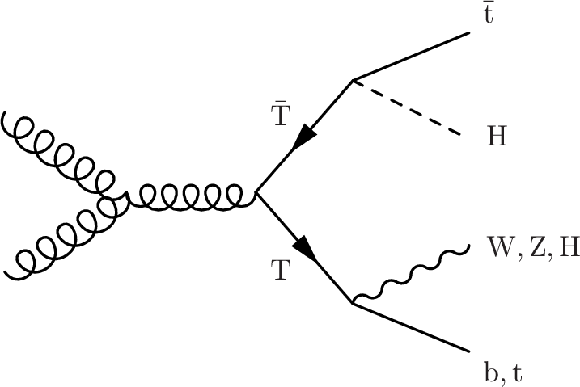
png pdf |
Figure 1:
Representative Feynman diagram for production of a $\mathrm {T\bar{T}}$pair with one T quark decaying to tH. |
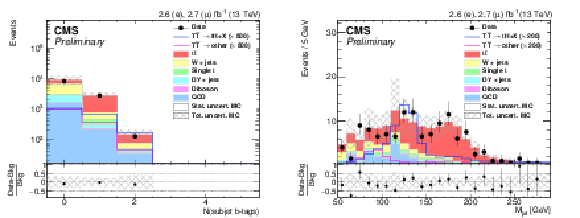
png pdf |
Figure 2:
Left: Distribution of the number of b-tagged subjets of the ${p_{\mathrm {T}}} $-leading Higgs candidate jet ($ {p_{\mathrm {T}}} > $ 300 GeV, $M_{\text{jet}} \in $ [60, 160 GeV]) without the subjet b-tag requirement. Right: Distribution of $ M_{text{jet}} $ of the ${p_{\mathrm {T}}} $-leading Higgs candidate jet ($ {p_{\mathrm {T}}} > $ 300 GeV) with at least two subjet b-tags before applying the mass cut. Both distributions are shown after the event selection described in Sec. 5.1 and all corrections described in Sec. 6 are applied to the MC. For the signal, the $ M_{\mathrm{T}} = $ 1200 GeV mass point is shown and the distributions are normalized to the corresponding theory cross section times the number behind the legend entry. A branching fraction of 33% to all three decay channels is assumed. The blue curve contains $\mathrm {T\bar{T}}$ events with at least one Higgs boson in the decay chain, the red curve shows $\mathrm {T\bar{T}}$ events where this is not the case. |
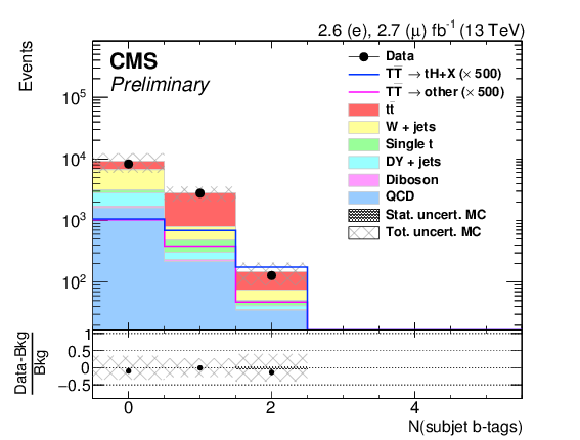
png pdf |
Figure 2-a:
Distribution of the number of b-tagged subjets of the ${p_{\mathrm {T}}} $-leading Higgs candidate jet ($ {p_{\mathrm {T}}} > $ 300 GeV, $M_{\text{jet}} \in $ [60, 160 GeV]) without the subjet b-tag requirement. The distribution is shown after the event selection described in Sec. 5.1 and all corrections described in Sec. 6 are applied to the MC. For the signal, the $ M_{\mathrm{T}} = $ 1200 GeV mass point is shown and the distribution is normalized to the corresponding theory cross section times the number behind the legend entry. A branching fraction of 33% to all three decay channels is assumed. The blue curve contains $\mathrm {T\bar{T}}$ events with at least one Higgs boson in the decay chain, the red curve shows $\mathrm {T\bar{T}}$ events where this is not the case. |
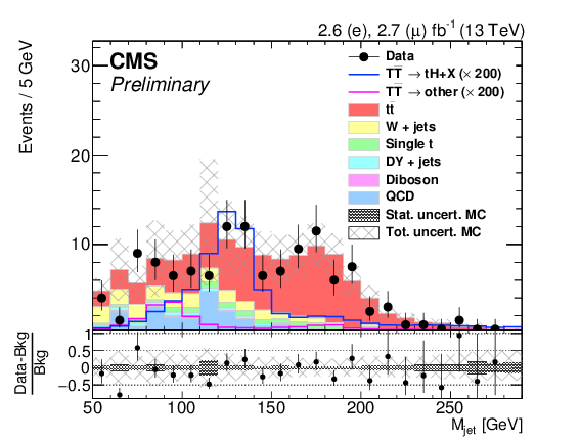
png pdf |
Figure 2-b:
Distribution of $ M_{text{jet}} $ of the ${p_{\mathrm {T}}} $-leading Higgs candidate jet ($ {p_{\mathrm {T}}} > $ 300 GeV) with at least two subjet b-tags before applying the mass cut. The distribution is shown after the event selection described in Sec. 5.1 and all corrections described in Sec. 6 are applied to the MC. For the signal, the $ M_{\mathrm{T}} = $ 1200 GeV mass point is shown and the distribution is normalized to the corresponding theory cross section times the number behind the legend entry. A branching fraction of 33% to all three decay channels is assumed. The blue curve contains $\mathrm {T\bar{T}}$ events with at least one Higgs boson in the decay chain, the red curve shows $\mathrm {T\bar{T}}$ events where this is not the case. |
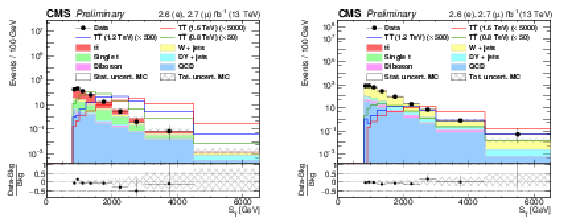
png pdf |
Figure 3:
Post-fit $S_{\mathrm {T}}$ distributions in the ${\mathrm{ t } \mathrm{ \bar{t} } }$ (left) and W+jets (right) control regions after applying all corrections and performing the maximum-likelihood fit described in the main text. The $\mathrm {T\bar{T}}$ signal is normalized to the theory cross section times the number behind the legend entry and a branching fraction of 100% of $ \mathrm{ T \rightarrow tH } $ is assumed. |
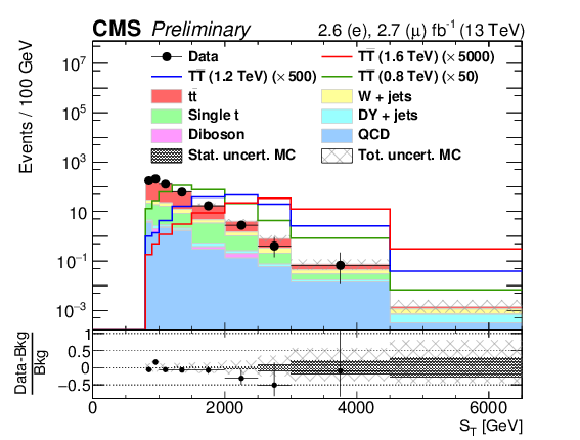
png pdf |
Figure 3-a:
Post-fit $S_{\mathrm {T}}$ distribution in the ${\mathrm{ t } \mathrm{ \bar{t} } }$ control region after applying all corrections and performing the maximum-likelihood fit described in the main text. The $\mathrm {T\bar{T}}$ signal is normalized to the theory cross section times the number behind the legend entry and a branching fraction of 100% of $ \mathrm{ T \rightarrow tH } $ is assumed. |
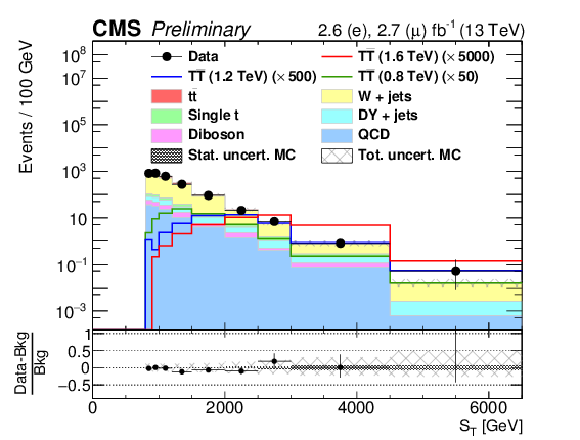
png pdf |
Figure 3-b:
Post-fit $S_{\mathrm {T}}$ distribution in the ${\mathrm{ t } \mathrm{ \bar{t} } }$ W+jets control region after applying all corrections and performing the maximum-likelihood fit described in the main text. The $\mathrm {T\bar{T}}$ signal is normalized to the theory cross section times the number behind the legend entry and a branching fraction of 100% of $ \mathrm{ T \rightarrow tH } $ is assumed. |
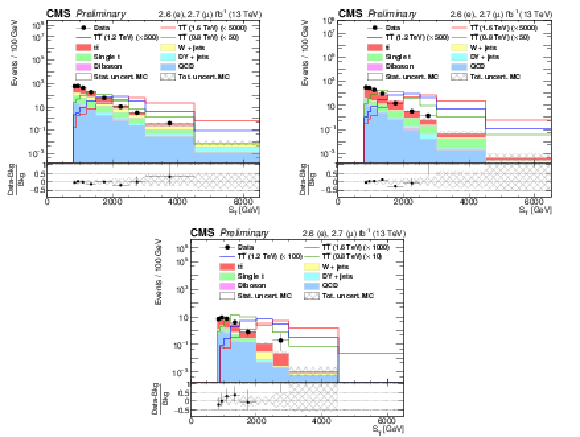
png pdf |
Figure 4:
Post-fit distributions of $S_{\mathrm {T}}$ in the 0H (top left), H1b (top right) and H2b (bottom) category after performing the maximum-likelihood fit described in Sec. 6. Signal samples are normalized to a cross section of 5 pb in the 0H and H1b categories and 1 pb in the H2b category. The $ \mathrm {T\bar{T}} $signal is normalized to the theory cross section times the number behind the legend entry and a branching fraction of 100% of $ \mathrm{ T \rightarrow tH } $ is assumed. |
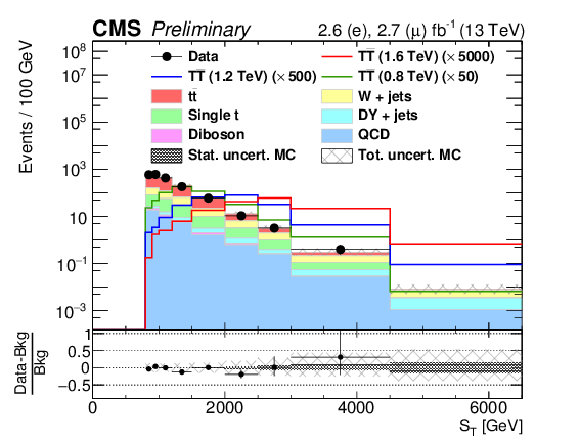
png pdf |
Figure 4-a:
Post-fit distribution of $S_{\mathrm {T}}$ in the 0H category after performing the maximum-likelihood fit described in Sec. 6. Signal samples are normalized to a cross section of 5 pb in the 0H and H1b categories and 1 pb in the H2b category. The $ \mathrm {T\bar{T}} $signal is normalized to the theory cross section times the number behind the legend entry and a branching fraction of 100% of $ \mathrm{ T \rightarrow tH } $ is assumed. |
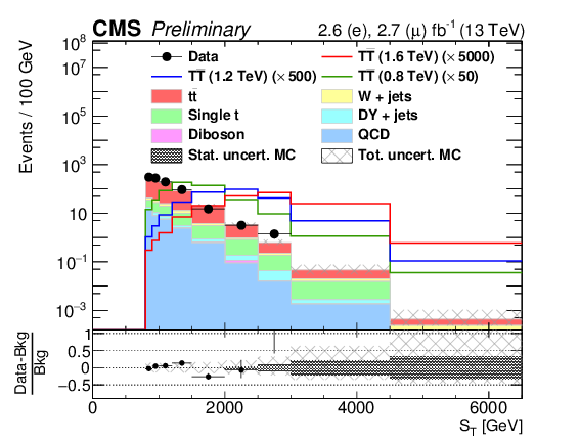
png pdf |
Figure 4-b:
Post-fit distribution of $S_{\mathrm {T}}$ in the H1b category after performing the maximum-likelihood fit described in Sec. 6. Signal samples are normalized to a cross section of 5 pb in the 0H and H1b categories and 1 pb in the H2b category. The $ \mathrm {T\bar{T}} $signal is normalized to the theory cross section times the number behind the legend entry and a branching fraction of 100% of $ \mathrm{ T \rightarrow tH } $ is assumed. |
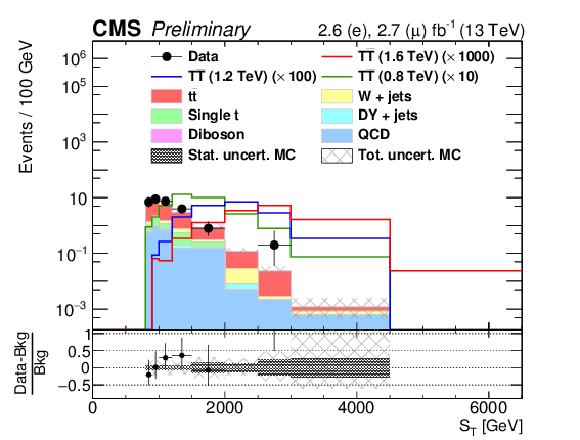
png pdf |
Figure 4-c:
Post-fit distribution of $S_{\mathrm {T}}$ in the H2b category after performing the maximum-likelihood fit described in Sec. 6. Signal samples are normalized to a cross section of 5 pb in the 0H and H1b categories and 1 pb in the H2b category. The $ \mathrm {T\bar{T}} $signal is normalized to the theory cross section times the number behind the legend entry and a branching fraction of 100% of $ \mathrm{ T \rightarrow tH } $ is assumed. |
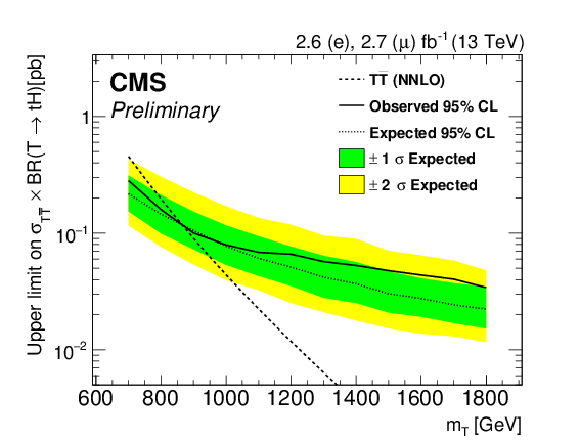
png pdf |
Figure 5:
Exclusion limits on the total cross-section of pair-produced T's with a branching fraction of 100% to tH. The theory cross section (dashed line) is computed at next-to-next-to-leading order. |
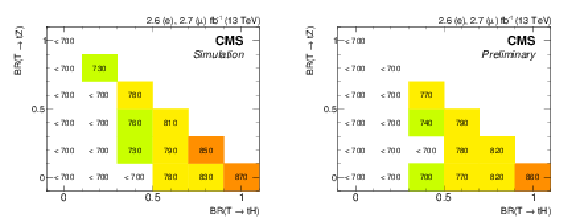
png pdf |
Figure 6:
Expected (left) and observed (right) upper mass limits in GeV for different combinations of $ \mathrm{ T \rightarrow tH } $ and $ \mathrm{ T \rightarrow tZ } $ branching fractions. The branching fraction $ \mathrm{ T \rightarrow bW } $ is, for each point in the triangle, 1 $-$ BR($ \mathrm{ T \rightarrow tH } $) $-$ BR($ \mathrm{ T \rightarrow tZ } $). |
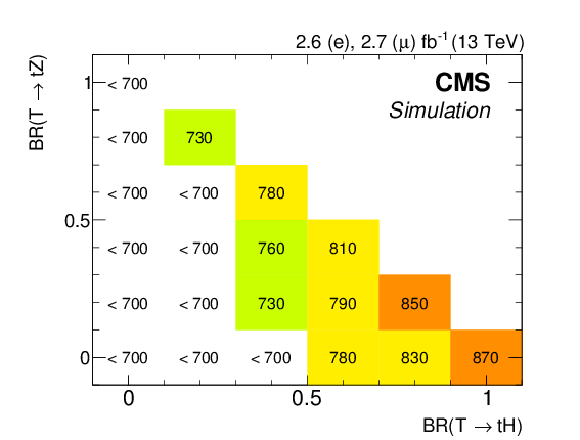
png pdf |
Figure 6-a:
Expected upper mass limit in GeV for different combinations of $ \mathrm{ T \rightarrow tH } $ and $ \mathrm{ T \rightarrow tZ } $ branching fractions. The branching fraction $ \mathrm{ T \rightarrow bW } $ is, for each point in the triangle, 1 $-$ BR($ \mathrm{ T \rightarrow tH } $) $-$ BR($ \mathrm{ T \rightarrow tZ } $). |
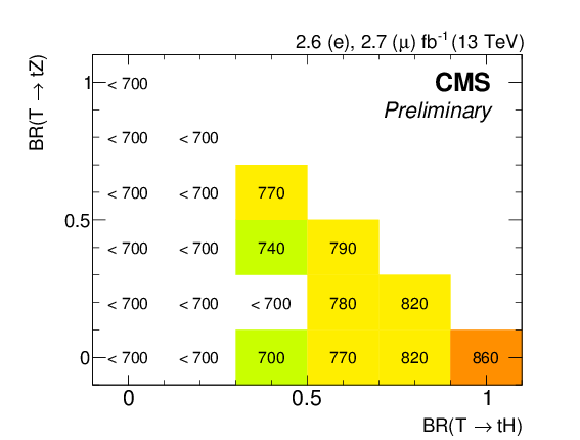
png pdf |
Figure 6-b:
Observed upper mass limit in GeV for different combinations of $ \mathrm{ T \rightarrow tH } $ and $ \mathrm{ T \rightarrow tZ } $ branching fractions. The branching fraction $ \mathrm{ T \rightarrow bW } $ is, for each point in the triangle, 1 $-$ BR($ \mathrm{ T \rightarrow tH } $) $-$ BR($ \mathrm{ T \rightarrow tZ } $). |
| Tables | |
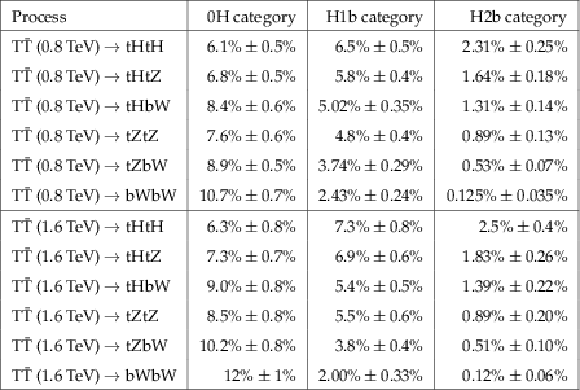
png pdf |
Table 1:
Signal efficiencies in the three event categories for two example mass points, split into the six possible final states. Uncertainties include both systematic and statistical uncertainties on the MC samples. |
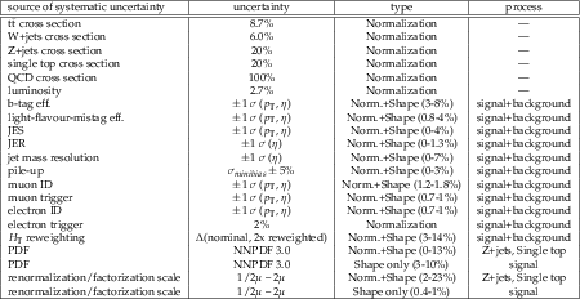
png pdf |
Table 2:
Summary of all systematic uncertainties, their sizes, types and to which processes they apply. |
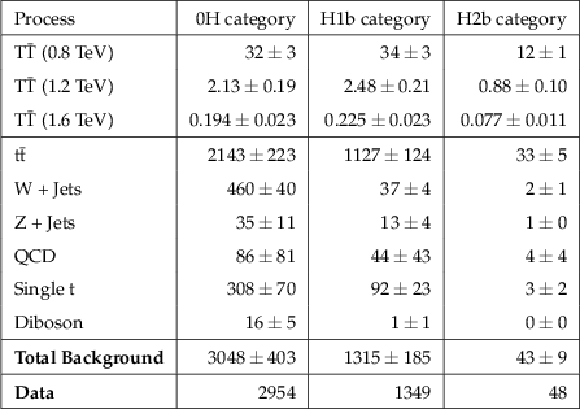
png pdf |
Table 3:
Event counts in the three final categories after performing the maximum-likelihood fit described in Sec. 6. Uncertainties comprise both statistical and systematic uncertainties. For the $\mathrm {T\bar{T}}$signal, the theoretically predicted production cross section with a branching fraction of 100% $ \mathrm{ T \rightarrow tH } $ is assumed. |
| Summary |
| We present a search for pair-produced vector-like T quarks analyzing data from pp collisions at a center-of-mass energy of $ \sqrt{s} = $ 13 TeV. The data were recorded by the CMS detector during the 2015 data-taking period and correspond to integrated luminosities of 2.6 fb$^{-1}$ and 2.7 fb$^{-1}$ in the electron and muon channel, respectively. The analysis requires at least one lepton in the final state and is optimized for the case that at least one of the T quarks decays to a Higgs boson and a top quark where the Higgs boson decays to $\mathrm{ b \bar{b} } $. Events are selected using substructure techniques to identify boosted Higgs bosons and the statistical interpretation of the results is conducted using $ S_{\mathrm{T}} $ as final discriminating variable. No excess above the Standard Model background is observed and upper 95% CL exclusion limits on the cross section of $ \mathrm{ T \bar{T} } $ production are calculated for various branching fraction scenarios. For a branching fraction of 100% $ \mathrm{ T \to tH } $, T quarks with masses up to 860 GeV can be excluded (870 GeV expected) which already exceeds the exclusion limits set by the 8 TeV analyses both by ATLAS and CMS [16-18] for this decay mode. |
| References | ||||
| 1 | ATLAS Collaboration | Observation of a new particle in the search for the Standard Model Higgs boson with the ATLAS detector at the LHC | PLB 716 (2012) 1 | |
| 2 | CMS Collaboration | Observation of a new boson at a mass of 125 GeV with the CMS experiment at the LHC | PLB 716 (2012) 30 | |
| 3 | M. Perelstein, M. E. Peskin, and A. Pierce | Top quarks and electroweak symmetry breaking in little Higgs models | PRD 69 (2004) 075002 | |
| 4 | O. Matsedonskyi, G. Panico, and A. Wulzer | Light top partners for a light composite Higgs | JHEP 01 (2013) 1 | |
| 5 | R. Contino, L. Da Rold, and A. Pomarol | Light custodians in natural composite Higgs models | PRD 75 (2007) 055014 | |
| 6 | R. Contino, T. Kramer, M. Son, and R. Sundrum | Warped/composite phenomenology simplified | JHEP 05 (2007) 074 | |
| 7 | D. B. Kaplan | Flavor at SSC energies: A new mechanism for dynamically generated fermion masses | Nuclear Physics B 365 (1991) 259 | |
| 8 | M. J. Dugan, H. Georgi, and D. B. Kaplan | Anatomy of a Composite Higgs Model | Nucl. Phys. B254 (1985) 299--326 | |
| 9 | Aguilar-Saavedra, J. A. | Mixing with vector-like quarks: constraints and expectations | EPJ Web of Conferences 60 (2013) 16012 | |
| 10 | F. del Aguila, J. A. Aguilar-Saavedra, and R. Miquel | Constraints on Top Couplings in Models with Exotic Quarks | PRL 82 (1999) 1628 | |
| 11 | The ALEPH, DELPHI, L3, OPAL, SLD Collaborations, the LEP Electroweak Working Group | Electroweak Measurements in Electron-Positron Collisions at W-Boson-Pair Energies at LEP | hep-ex/1302txyz | |
| 12 | O. Eberhardt et al. | Impact of a Higgs Boson at a Mass of 126 GeV on the Standard Model with Three and Four Fermion Generations | PRL 109 (2012) 241802 | |
| 13 | A. Djouadi and A. Lenz | Sealing the fate of a fourth generation of fermions | PLB 715 (2012) 310 | |
| 14 | J. A. Aguilar-Saavedra, R. Benbrik, S. Heinemeyer, and M. P\'erez-Victoria | Handbook of vectorlike quarks: Mixing and single production | PRD 88 (2013) 094010 | |
| 15 | A. De Simone, O. Matsedonskyi, R. Rattazzi, and A. Wulzer | A first top partner hunter's guide | JHEP 04 (2013) 1 | |
| 16 | CMS Collaboration | Inclusive search for a vector-like T quark with charge $ \frac{2}{3} $ in pp collisions at $ \sqrt{s} $ = 8 TeV | PLB 729 (2014) 149 | CMS-B2G-12-015 1311.7667 |
| 17 | ATLAS Collaboration | Search for pair production of a new heavy quark that decays into a $ W $ boson and a light quark in $ pp $ collisions at $ \sqrt{s}= $ 8 TeV with the ATLAS detector | PRD 92 (2015) 112007 | |
| 18 | ATLAS Collaboration | Search for production of vector-like quark pairs and of four top quarks in the lepton-plus-jets final state in pp collisions at $ \sqrt{s}= $ 8 TeV with the ATLAS detector | JHEP 08 (2015) 1 | |
| 19 | CMS Collaboration | The CMS experiment at the CERN LHC | JINST 3 (2008) S08004 | CMS-00-001 |
| 20 | CMS Collaboration | Particle-flow event reconstruction in CMS and performance for jets, taus, and $ E_{\mathrm{T}}^{\text{miss}} $ | CDS | |
| 21 | CMS Collaboration | Commissioning of the particle-flow event with the first LHC collisions recorded in the CMS detector | CDS | |
| 22 | CMS Collaboration | Performance of electron reconstruction and selection with the CMS detector in proton-proton collisions at $ \sqrt{s}= $ 8 TeV | JINST 10 (2015) P06005 | CMS-EGM-13-001 1502.02701 |
| 23 | CMS Collaboration | Performance of CMS muon reconstruction in $ pp $ collision events at $ \sqrt{s}= $ 7 TeV | JINST 7 (2012) P10002 | CMS-MUO-10-004 1206.4071 |
| 24 | M. Cacciari, G. P. Salam, and G. Soyez | The anti-$ k_t $ jet clustering algorithm | JHEP 04 (2008) 063 | 0802.1189 |
| 25 | M. Cacciari, G. P. Salam, and G. Soyez | FastJet user manual | EPJC 72 (2012) 1896 | 1111.6097 |
| 26 | M. Cacciari, G. P. Salam, and G. Soyez | The catchment area of jets | JHEP 04 (2008) 005 | 0802.1188 |
| 27 | CMS Collaboration | Determination of jet energy calibration and transverse momentum resolution in CMS | JINST 6 (2011) P11002 | CMS-JME-10-011 1107.4277 |
| 28 | P. Nason | A New method for combining NLO QCD with shower Monte Carlo algorithms | JHEP 11 (2004) 040 | hep-ph/0409146 |
| 29 | S. Frixione, P. Nason, and C. Oleari | Matching NLO QCD computations with Parton Shower simulations: the POWHEG method | JHEP 11 (2007) 070 | 0709.2092 |
| 30 | S. Alioli, P. Nason, C. Oleari, and E. Re | A general framework for implementing NLO calculations in shower Monte Carlo programs: the POWHEG BOX | JHEP 06 (2010) 043 | 1002.2581 |
| 31 | S. Frixione, P. Nason, and G. Ridolfi | A Positive-weight next-to-leading-order Monte Carlo for heavy flavour hadroproduction | JHEP 09 (2007) 126 | 0707.3088 |
| 32 | J. Alwall et al. | The automated computation of tree-level and next-to-leading order differential cross sections, and their matching to parton shower simulations | JHEP 07 (2014) 079 | 1405.0301 |
| 33 | J. Alwall et al. | MadGraph 5: going beyond | JHEP 06 (2011) 1 | |
| 34 | T. Sjostrand, S. Mrenna and P. Skands | PYTHIA 6.4 Physics and Manual | JHEP 05 (2006) 026 | hep-ph/0603175 |
| 35 | T. Sjostrand et al. | An Introduction to PYTHIA 8.2 | CPC 191 (2015) 159--177 | 1410.3012 |
| 36 | M. Czakon and A. Mitov | Top++: A Program for the Calculation of the Top-Pair Cross-Section at Hadron Colliders | CPC 185 (2014) 2930 | |
| 37 | M. Czakon, P. Fiedler, and A. Mitov | Total Top-Quark Pair-Production Cross Section at Hadron Colliders Through $ O(\alpha\frac{4}{S}) $ | PRL 110 (2013) 252004 | |
| 38 | M. Czakon and A. Mitov | NNLO corrections to top pair production at hadron colliders: the quark-gluon reaction | JHEP 01 (2013) 080 | |
| 39 | M. Czakon and A. Mitov | NNLO corrections to top-pair production at hadron colliders: the all-fermionic scattering channels | JHEP 12 (2012) 054 | |
| 40 | P. Barnreuther, M. Czakon, and A. Mitov | Percent Level Precision Physics at the Tevatron: First Genuine NNLO QCD Corrections to $ q \bar{q} \to t \bar{t} + X $ | PRL 109 (2012) 132001 | |
| 41 | M. Cacciari et al. | Top-pair production at hadron colliders with next-to-next-to-leading logarithmic soft-gluon resummation | PLB 710 (2012) 612 | |
| 42 | NNPDF Collaboration | Parton distributions for the LHC Run II | JHEP 04 (2015) 040 | 1410.8849 |
| 43 | GEANT4 Collaboration | GEANT4: A simulation toolkit | NIMA 506 (2003) 250--303 | |
| 44 | CMS Collaboration | Measurement of the Inclusive $ W $ and $ Z $ Production Cross Sections in $ pp $ Collisions at $ \sqrt{s}=7 $ TeV | JHEP 10 (2011) 132 | CMS-EWK-10-005 1107.4789 |
| 45 | A. J. Larkoski, S. Marzani, G. Soyez, and J. Thaler | Soft Drop | JHEP 05 (2014) 146 | 1402.2657 |
| 46 | CMS Collaboration | Identification of b-quark jets with the CMS experiment | JINST 8 (2013) P04013 | CMS-BTV-12-001 1211.4462 |
| 47 | CMS Collaboration | Identification of b quark jets at the CMS Experiment in the LHC Run 2 | CMS-PAS-BTV-15-001 | CMS-PAS-BTV-15-001 |
| 48 | CMS Collaboration | Search for $ \mathrm{t\bar{t}} $ resonances in boosted semileptonic final states in pp collisions at $ \sqrt{s}= $ 13 TeV | CMS-PAS-B2G-15-002 | CMS-PAS-B2G-15-002 |
| 49 | N. Kidonakis | Top Quark Production | in Proceedings, Helmholtz International Summer School on Physics of Heavy Quarks and Hadrons (HQ 2013) | 1311.0283 |
| 50 | M. Aliev et al. | HATHOR: HAdronic Top and Heavy quarks crOss section calculatoR | CPC 182 (2011) 1034 | 1007.1327 |
| 51 | P. Kant et al. | HatHor for single top-quark production: Updated predictions and uncertainty estimates for single top-quark production in hadronic collisions | CPC 191 (2015) 74 | 1406.4403 |
| 52 | T. Muller, J. Ott, and J. Wagner-Kuhr | theta - a framework for template-based modeling and inference | ||
| 53 | A. O'Hagan and J. J. Forster | Kendall?s Advanced Theory of Statistics. Vol. 2B: Bayesian Inference | Arnold, London | |
| 54 | R. Barlow and C. Beeston | Fitting using finite Monte Carlo samples | CPC (1993) 219 | |
| 55 | CMS Collaboration | Search for pair-produced vector-like B quarks in proton-proton collisions at $ \sqrt{s} $ = 8 TeV | CMS-B2G-13-006 1507.07129 |
|
| 56 | ATLAS Collaboration | Search for vectorlike $ B $ quarks in events with one isolated lepton, missing transverse momentum, and jets at $ \sqrt{s}= $ 8 TeV with the ATLAS detector | PRD 91 (2015) 112011 | |

|
Compact Muon Solenoid LHC, CERN |

|

|

|

|

|

|